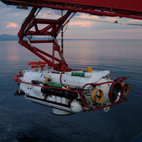- Products
- Commercial divers’ equipment
- Compasses and watches
- Defence divers’ equipment
- Diving instrumentation
- Electrical diving equipment
- Escape and abandonment
- Gas and fluid systems
- Medical and safety equipment
- Recompression chambers
- Submarine intervention
- Submarine rescue
- Tactical Diving Vehicles
- Ansti testing equipment
- Services
- Consultancy and personnel
- Engineering services
- Rescue and support
- Testing services
- Training services
- Ancillary dive gear
- Commercial equipment and tools
- Commercial helmets, masks and SCUBA
- Commercial rebreathers
- Commercial surface supply
- Diver's suits and harnesses
- Contaminated water diving system
- BIBS manifold block
- Divex back pressure regulator
- Divex interlock
- Hy-Fex hyperbaric fire extinguisher
- Hyperbaric flame detector
- Hyperlite hyperbaric stretcher
- Oxygen kits
- Ultralite 2 BIBS mask
- InVicto ventilator system
- DSAR rescue vehicles
- Launch and recovery systems
- Multi-role launch and recovery system
- Submarine rescue bell
- Client representatives
- Dive and ROV system audits
- Diving technical expertise
- Offshore personnel
- Rescue certification
- Remote audit solution
- Altitude testing and trials
- Hyperbaric welding
- Pressure testing and trials
- Test tank
- Breathing laboratory
- Commercial development courses
- Defence training courses
- Medical training courses
- Product specific courses
- Online training courses
- Classroom training FAQ
- Case Study: Roger Chapman Pisces III
- Case Study: HMS Edinburgh
- ANSTI CSTF
- Akademik Tofiq Ismayilov (ATI)
- Archive
- JFD strengthens Commercial Diving business with leadership appointments
- JFD unveils new product concept ‘Stealth Multi-Role’ at key industry events
- JFD North America enhances US Navy Submarine Rescue capabilities with advanced Integrated Communication System
- JFD successfully integrates and delivers advanced submarine rescue system for Republic of Korea Navy
- Archive
- Divulged - Winter 2017
- Divulged - Summer 2017
- Divulged - Winter 2016
- Divulged - Summer 2018
- Divulged - Winter 2018
- Divulged - Winter 2019
- Divulged 2021 Edition 1
- UDT 2019
- Visit JFD at UI 2016
- Visit us at OTC Asia 2018
- Visit JFD on stand 338 at Underwater Intervention 2018
- JFD is exhibiting at ONS 2018
- JFD is exhibiting at OSEA 2018
- Join JFD at IDEX 2019
- See JFD at Subsea Expo 2019
- JFD takes on BALT Military Expo
- JFD presents complete defence offering at UDT 2018 in Glasgow
- Join JFD at ADIPEC 2018
- Visit JFD at Pacific 2017
- Visit JFD at MSPO 2018 in Poland
- JFD presenting at UDT conference
- JFD is exhibiting alongside James Fisher Nigeria at NOG
- JFD exhibiting at UDT 2016
- Visit JFD at Underwater Intervention 2019
- JFD is participating at Underwater Defence & Security
- See JFD at this year’s IMCA Annual Seminar
- JFD is exhibiting at LAAD Defence & Security 2019
- JFD LEXMAR is exhibiting at OSEA 2016
- JFD is exhibiting at Subsea Expo 2017
- Visit JFD at Indo Defence 2018 Expo and Forum
- Visit JFD on stand 403 at Underwater Intervention 2017
- JFD exhibiting at Europoltech
- JFD at IMDEX
- Visit JFD at UDT 2017
- Visit JFD at DSEI 2017
- JFD is exhibiting at OTC 2018
- JFD is exhibiting at Subsea EXPO 2018
- JFD is exhibiting at Sea Air Space 2018
- Visit JFD at DSA 2018
- See JFD at Defexpo 2018
- JFD is exhibiting at ADIPEC 2017
- Come see JFD at DSEI!
- See JFD at IMDEX Asia 2019
- JFD is at Oil & Gas Asia 2019
- Experience DSEI with JFD
- See JFD's full defence capability at MSPO 2019
- JFD is exhibiting at this year's Offshore Europe
- Visit us on stand 2S16 at Pacific
- See JFD at ADIPEC on stand 13572
- Explore our commercial capabilities at Bergen International Diving Seminar
- JFD showcasing commercial and defence capabilities at Underwater Intervention
- JFD exhibiting alongside James Fisher Offshore at Subsea Expo
- Visit our stand at DSEI 2021!
- Join JFD at Subsea Expo 2022
- Visit JFD Australia at Indo Pacific 2022
- JFD North America is exhibiting at SOFIC 2022
- Experience CNE 2022 with JFD
- Discover JFD at UDT 2022
- Join JFD at GSOF Symposium Europe this October
Submarine rescue exercise success
 In May and June James Fisher Defence took part in Black Carillon, a Royal Australian Navy exercise to test its systems for the safe evacuation of a stranded submarine.
In May and June James Fisher Defence took part in Black Carillon, a Royal Australian Navy exercise to test its systems for the safe evacuation of a stranded submarine.
The submarine rescue capability of the Royal Australian Navy is provided by James Fisher Defence in the form of the James Fisher Submarine Rescue Service. For the exercise, five distinct phases were to be tested; comprising mobilisation, system handover, workup, exercise and demobilisation.
During the mobilisation phase, James Fisher Submarine Rescue Service (JFSRS) transferred the rescue suite and associated systems from Henderson to the Defence Maritime Services (DMS) vessel Seahorse Standard (SHS). This was conducted at the Common User Facility at Henderson instead of at the HMAS Stirling naval base (Fleet Base West), in order to test the system’s ability to deploy from a commercial sea port. Initial workup was conducted together with navy personnel in nearby Cockburn Sound. Both the LR5 manned submersible and the Scorpio 45 remotely operated vehicle (ROV) were launched and recovered in approximately 20m of water in order to check the system functionality and the capability of deck teams in a sheltered environment.
The main part of the exercise took place at sea in the Western Australia exercise area. Here, Collins class submarine HMAS Waller was bottomed to simulate a submarine that had suffered a catastrophic event and was unable to reach the surface. The ROV was used to conduct a hull survey and ensure the escape tower upper hatch and surrounding area were undamaged and free from obstructions. If required, the ROV is equipped with two manipulators, one of which has a cutter and could remove obstructions from the submarine. The LR5 submersible was then launched to conduct rescue operations.
In total the LR5 successfully transferred 44 people and spent over 23 hours submerged. A casualty evacuation exercise was conducted where a medical team entered in to the Collins class submarine HMAS Waller and an immobile patient was stabilised and removed from the submarine to the surface. Continuous cycles of the LR5 were conducted in order to obtain an indicative time for the rescue of an entire submarine crew. The exercise was seen as a great success by all involved, with all key objectives met or exceeded. The rescue system proved it was more than capable of rescuing an entire Collins class complement and further demonstrates James Fisher Defence’s capability in the crucial area of submarine rescue.




